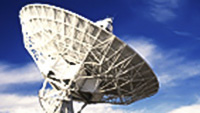Search and order online
VLBI: The sharpest views in radio-astronomy
- Video Tape only
- Title VLBI: The sharpest views in radio-astronomy
- Released: 07/02/2007
- Language English
- Footage Type Documentary
- Copyright ESA
- Description
VLBI - the sharpest views in radio astronomy
ESA TV Exchanges
Around the planet, astronomers have huge parabolic dishes and large arrays of antennas turned towards the skies radio telescopes. The European hub for what is called Very Long Baseline Interferometry is situated in Dwingeloo in the Netherlands. Its there, at the Joint Institute for VLBI in Europe JIVE - that are processed the signals of radio telescopes. The script is online as a PDF file under http://television.esa.int/photos/EbS55492.pdf
A WMV preview clip is online under : http://esatv-movies.e-vision.nl/videos/mphi/VLBI_07-02-07_wmphigh.wmvVLBI ñ the sharpest views of the invisible
A-Roll start
10:00:00
10:00:40
Around the planet, astronomers have huge parabolic dishes and large
arrays of antennas turned towards the skies... radio telescopes.
10:00:51
Radio astronomy, which extends the observable electromagnetic spectrum
by many orders of magnitude, is relatively young. The first detection of
radio waves from the cosmos dates from the 1930s. It has since allowed,
for example, the discovery of pulsars and quasars.
10:01:10
But radio telescopes must be very large, in theory several kilometres in
diameter to achieve the same resolution as optical telescopes. The only
way to do this is by coupling two or more of them, the further apart the
better, and to analyse their combined signals.
10:01:28
Clip Leonid Gurvits, JIVE Senior astronomer
« According to the fundamental laws of physics, angular resolution or
sharpness of vision depends on the size of the receiver of your telescope.
To avoid increase of expenses due to
- Length 12:34:00
- Format BETACAM
- Commercial Use No
- Producer Ingrid van de Vijver
- Executive World Wide Pictures


